Home / Protecting Groups For Alcohols
Alcohols, Epoxides and Ethers
Protecting Groups For Alcohols
Last updated: April 10th, 2025 |
Alcohol Protecting Groups
- There are many times when it’s useful to mask the reactivity of alcohols since their relatively high acidity interferes with strongly basic reagents like Grignard reagents.
- The most common protecting group for alcohols is silyl ethers.They are easily formed by treating alcohols with R3SiCl in the presence of base, and then easily removed with a source of fluoride ion F(-) since Si-F bonds are very strong.
- Silyl ethers are inert to Grignard reagents, strong bases, and oxidants (although will be removed with strong acid).
- Tetrahydropyranyl (THP) ethers are also useful protecting groups for alcohols.
- Ordinary ethers are generally not used as protecting groups since their removal requires harsh conditions
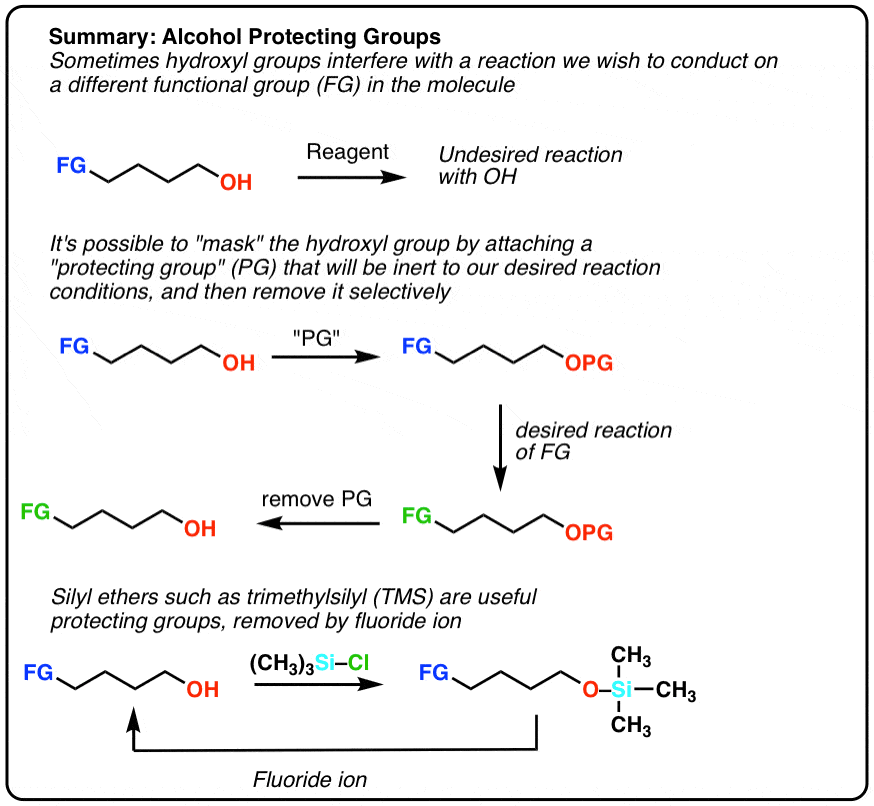
Table of Contents
- When Alcohols Get In The Way
- Protecting Groups Are Like “Painter’s Tape”
- What Would Be A Chemical Equivalent of “Painter’s Tape”?
- One Potential Solution: Ethers (Spoiler: They’re Not Great)
- A Better Way To Do It: Silyl Ethers
- A Successful Application of a Silyl Protecting Group Strategy
- Summary: Protecting Groups For Alcohols
- Notes
- Quiz Yourself!
- (Advanced) References and Further Reading
1. When Alcohols Get In the Way
As we’ve seen in previous posts in this series, alcohols are very versatile functional groups that participate in a variety of reactions. They can be deprotonated with base (making them good nucleophiles in substitution reactions), protonated (making them good leaving groups in substitution and elimination reactions), oxidized to aldehydes or ketones, or transformed into better leaving groups (alkyl halides, or alkyl tosylates) allowing for a host of substitution and elimination reactions.
All this this versatility comes with a drawback, however. Sometimes alcohol functional groups can get in the way of other reactions we might like to do. Let me show you what I mean.
We’ve seen by now one of the most useful C-C bond forming reactions you learn in Org 1: nucleophilic substitution (SN2) of alkyl halides with acetylides (the conjugate base of acetylenes)

Since alkynes are like a blank canvas, this reaction can set up the introduction of many different types of functional groups through addition reactions.
Now let’s modify our substrate a bit. We’ll attach a hydroxyl group (OH) to the end of the molecule. Now let’s see what happens.
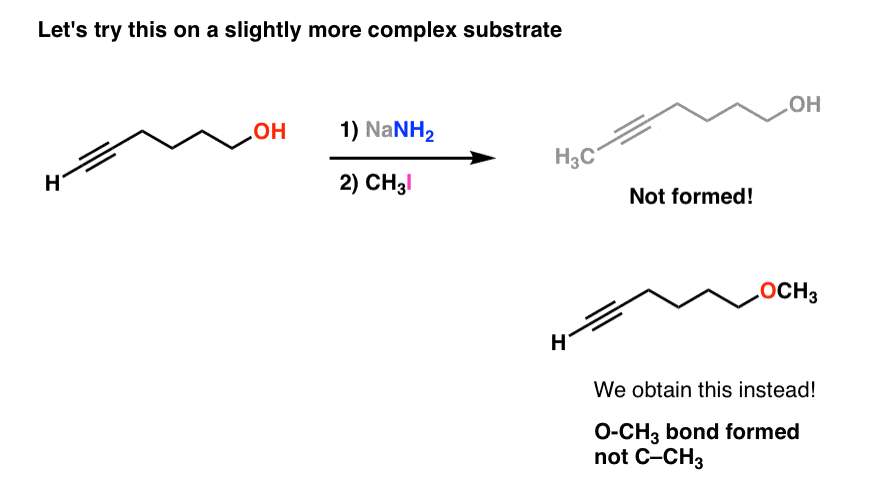
Look at what happened – we now formed a new O-CH3 bond instead of a C-C bond. What gives?
The answer, of course, is that our strong base NaNH2 deprotonated the strongest acid [OH, pKa of 16 versus acetylide C-H, pKa of 25] and the resulting alkoxide [R–O– ] then attacked CH3-I, resulting in a substitution reaction with displacement of iodide ion [Note 1]
Here’s another example of the the principle at work. Here, we’d like to perform a substitution reaction of C-Br with C-C . So why does this reaction not lead to formation of a C-C bond?

Same reason! Our acetylide ion is a strong base, and deprotonates the O-H group, which then participates in an SN2 reaction with the alkyl halide 4 bonds away (forming a five membered ring).
This is a textbook example of what we saw in our last post – an intramolecular SN2 reaction. [Why doesn’t it do substitution first? Acid-base reactions are fast, relative to substitution reactions].
So how could we have prevented this from occurring?
2. Protecting Groups Are Like Painter’s Tape
It’s reminiscent of a problem anyone who has painted a room would understand. Imagine you’re helping your cousin paint his room in a hideous shade of yellow-green so completely uncool to the untrained eye that only a hipster could appreciate it. Then you come to one of those annoying wall outlets. You could paint over it of course.

But now it’s useless if your cousin wants to plug in that 1965 Smith-Corona electric typewriter he found at a thrift store that he’s using to write his “novel”. Surely there’s a way to do this that doesn’t destroy our outlet. So what do you do?
Painter’s tape to the rescue!

Cover the outlet with painter’s tape, paint to your heart’s content, then remove the tape. THEN you can plug in the typewriter. Simple!
3. A Chemical Equivalent Of Painter’s Tape
Wouldn’t it be nice if we had a “chemical equivalent” of painter’s tape for alcohols. Something that could
- mask the reactivity of the OH group
- be inert to a large set of reaction conditions, and
- be easily and selectively removed to reveal the OH group once we’re done.
That would allow us to perform a synthesis of our desired molecule (second scheme above). Here I’m using “PG” to stand for “protective group”.
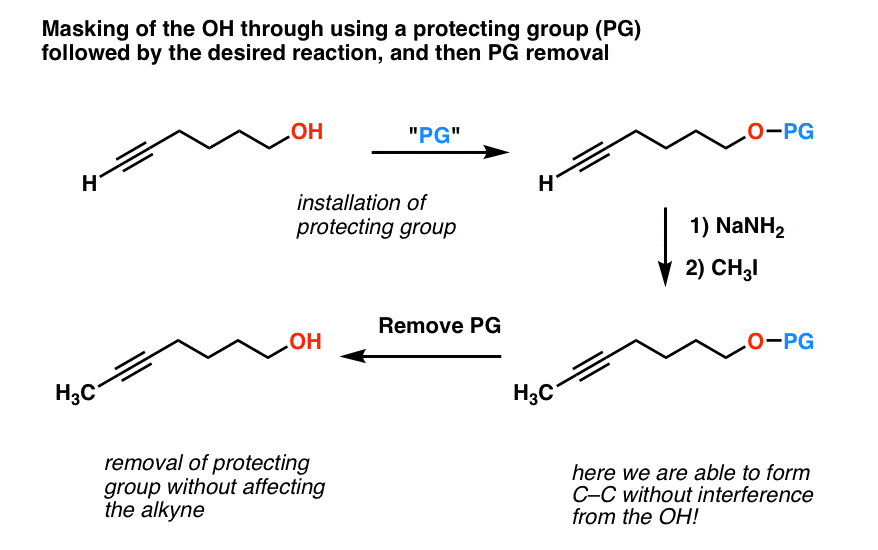
Well, you might have guessed by now that enterprising chemists have developed a solution for this problem. It’s very clever, in fact.
4. One Potential Solution: Ethers
As we’ve discussed earlier, ethers are quite possibly the most boring functional group you can encounter. The only important reaction of ethers you cover in Org 1 is how to cleave them with very strong acid (e.g. with hydroiodic acid, HI). That’s it. Other than that, ethers are inert to pretty much any other reaction condition you can name.
For the chemical equivalent of “painter’s tape”, boring is good! It means that we can “protect” a hydroxyl group as an ether without worrying about it being affected by reactions we might like to do on the rest of the molecule (like addition of an acetylide to an alkyl halide, for example).
There’s just one problem: ethers require very harsh conditions in order to break (hydroiodic acid, HI). That’s like destroying the village in order to save it: such conditions will likely torch whatever other functional groups are on your molecule.

5. A Better Way To Do It: Silyl Ethers
Fortunately a very clever solution has been devised. Instead of making a typical ether (e.g. forming an O-C bond), we form a silyl ether (i.e. make an O-Si bond, not an O–C bond). It’s even easier to form than a “normal” ether, and shares the property of being inert to many types of reaction conditions. In most introductory courses the most common silyl ether used is trimethylsilyl (TMS) although there are others [Generally, the bulkier the groups around silicon, the harder it is to cleave the O–Si bond]
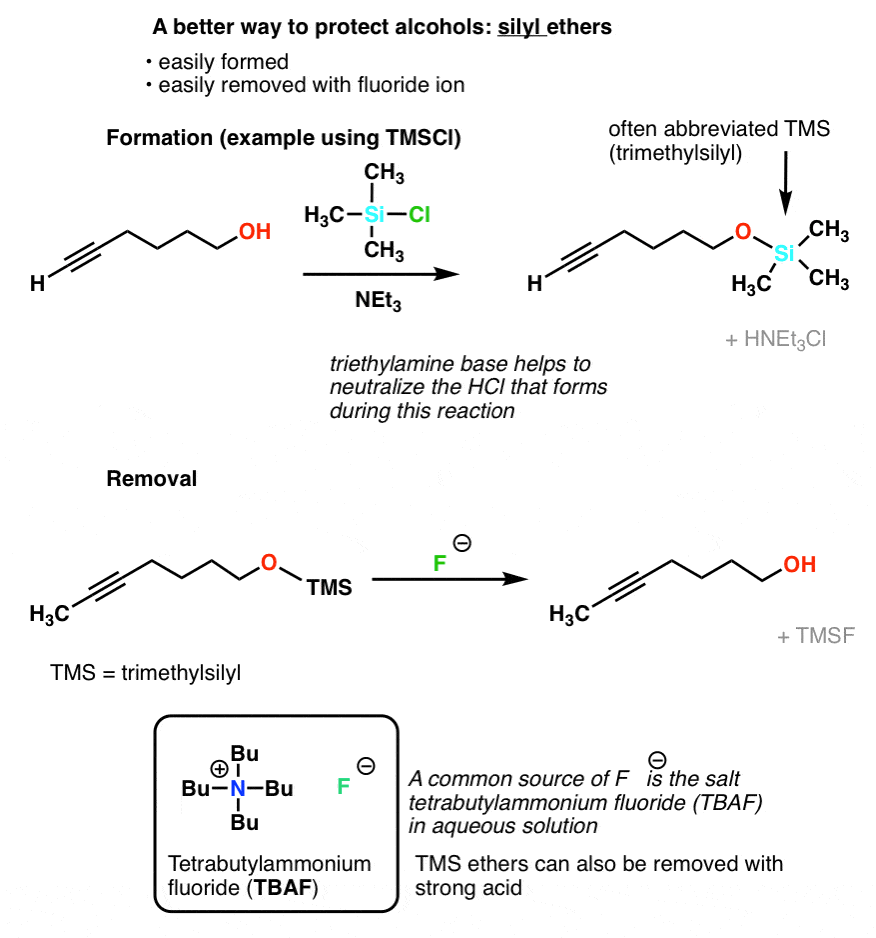
The main advantage of silyl ethers is that they’re easily cleavable. The Si-F bond is unusually strong – even stronger than Si-O. Addition of a source of fluoride ion (F-) will lead to cleavage of Si-O bonds without affecting the rest of the molecule. A typical source of fluoride ion is the salt tetrabutylammonium fluoride (TBAF).
Are there other protecting groups for alcohols? You betcha. For more information, see Note 2.
6. A Successful Application of A Silyl Ether Protective Group Strategy
So let’s go back to our second example. How could we get this sequence to work? Let’s “protect” the free alcohol as a silyl ether (TMS) and follow along.
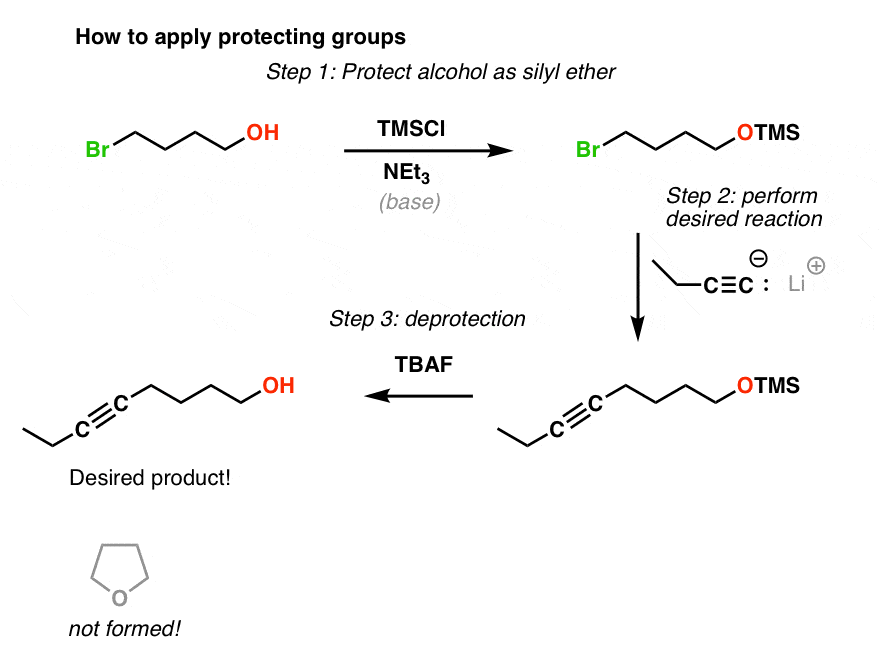
There you have it. All we needed to get our desired reaction to work was a way of masking the OH until we were done performing our surgery on the other half of the molecule.
7. Summary: Protecting Groups For Alcohols
This post barely scratches the surface of protecting groups for alcohols. Protecting groups are used for alcohols in a variety of different situations, far beyond the SN2 examples we covered here. For instance, when we talk about Grignard reagents, we’ll see that they can’t be formed in the presence of alcohols, so we have to protect them. Another example might be if you wanted to selectively oxidize one of two different alcohols in a molecule. We can add more posts on this topic as we go along.
You’ll notice that the vast majority of molecules you encounter in Org 1 and Org 2 have only one important functional group. It’s very rare that you’ll be given a substitution reaction, for example, that has two nucleophiles of comparable strength. Learning how to deal with molecules that have more than one key functional group is, in my opinion, where Org 2 ends and Org 3 begins.
It’s at that point that you need to learn understand the relative reactivity of different functional groups, their compatibility with different reagents, and also how to plan a synthesis such that only one key functional group will participate in the reaction.
Next Post – Thiols And Thioethers
Notes
Related Articles
Note 1. Isn’t it possible that NaNH2 could have deprotonated a little bit of the alkyne? Sure! But remember that acid base reactions are equilibrium, and the alcohol is a far stronger acid (pKa ~16 ) than the alkyne (pka 25). Even if that acetylide formed, it would be quickly protonated by any spare alcohol R-OH swimming around, giving rise to the alkoxide. [back to article]
Note 2. Two more protecting groups that come up quite frequently are TBS (t-butyldimethylsilyl) and THP (tetrahydropyranyl) ethers. TBS is installed the exact same way TMS is – by using TBSCl in the presence of a base like NEt3.
THP ethers are slightly different. They are installed by adding dihydropyran (an “enol ether”) in the presence of strong acid. The enol ether is protonated at carbon by the strong acid, resulting in an oxonium ion, which is then attacked by the alcohol to give the ether. This is actually a special type of ether where two OR groups are attached to the same carbon. It’s a masked ketone, which we refer to as an acetal. We talk about acetals here in this blog post. [back to article]
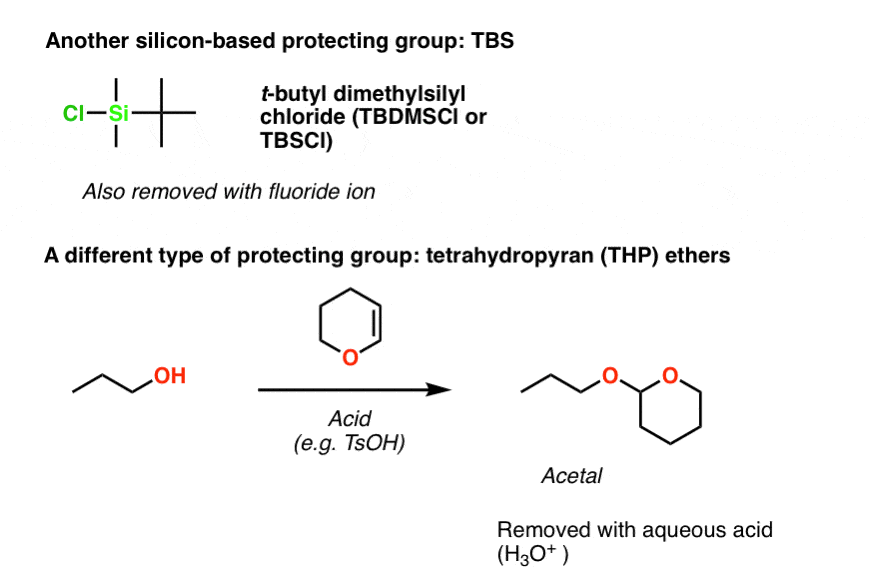
For even more protecting groups for alcohols, see this handout by the group of Prof. Andrew Myers at Harvard. It’s phenomenal.
Quiz Yourself!

Become a MOC member to see the clickable quiz with answers on the back.

Become a MOC member to see the clickable quiz with answers on the back.
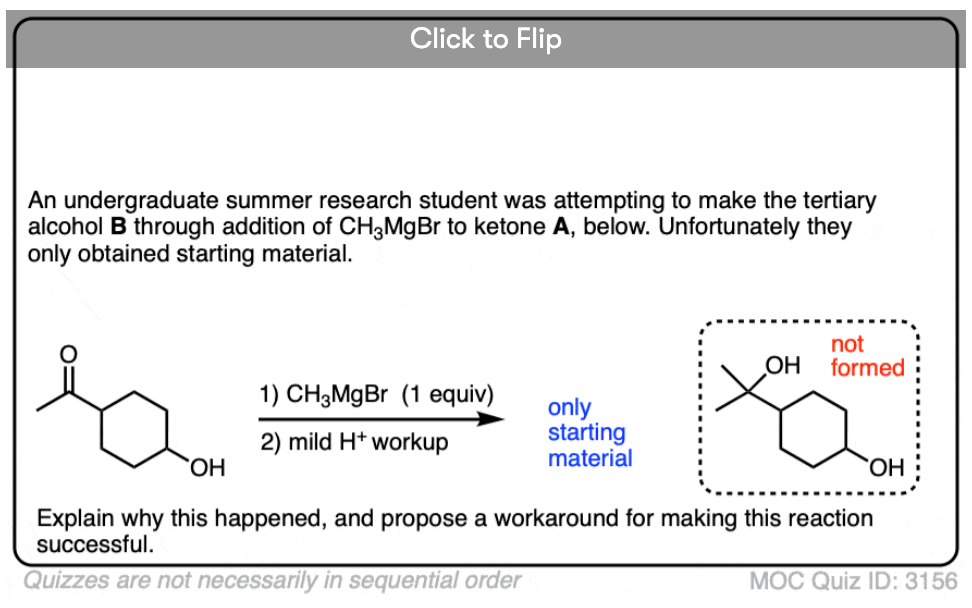
Become a MOC member to see the clickable quiz with answers on the back.

Become a MOC member to see the clickable quiz with answers on the back.
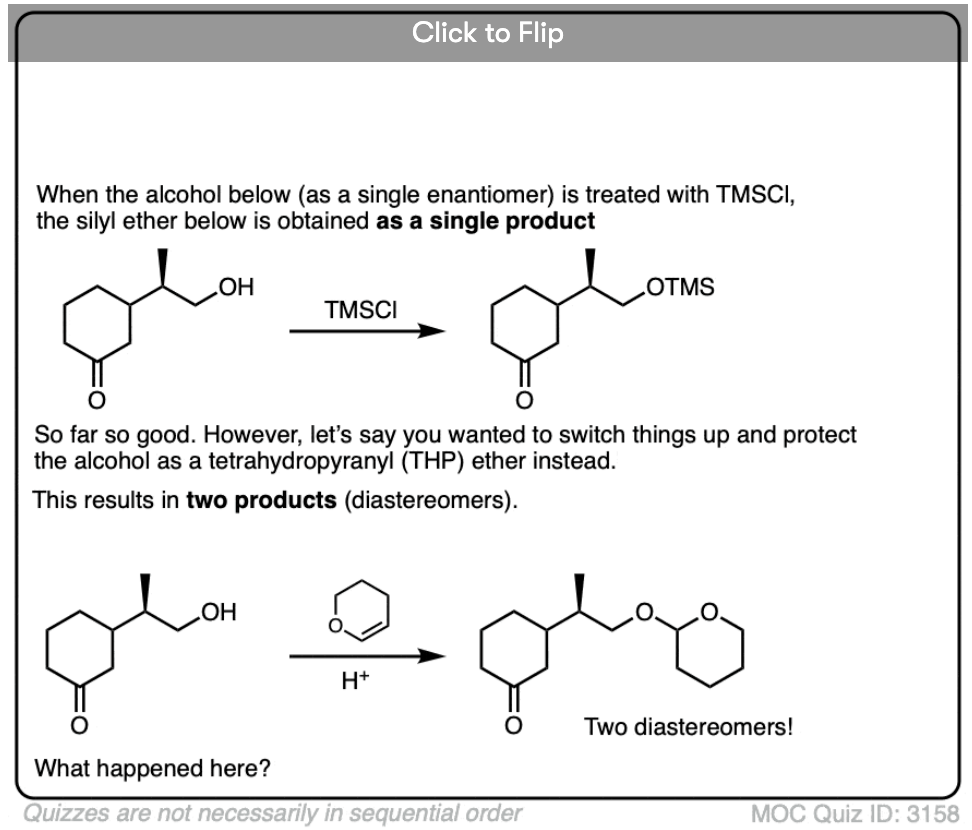
Become a MOC member to see the clickable quiz with answers on the back.
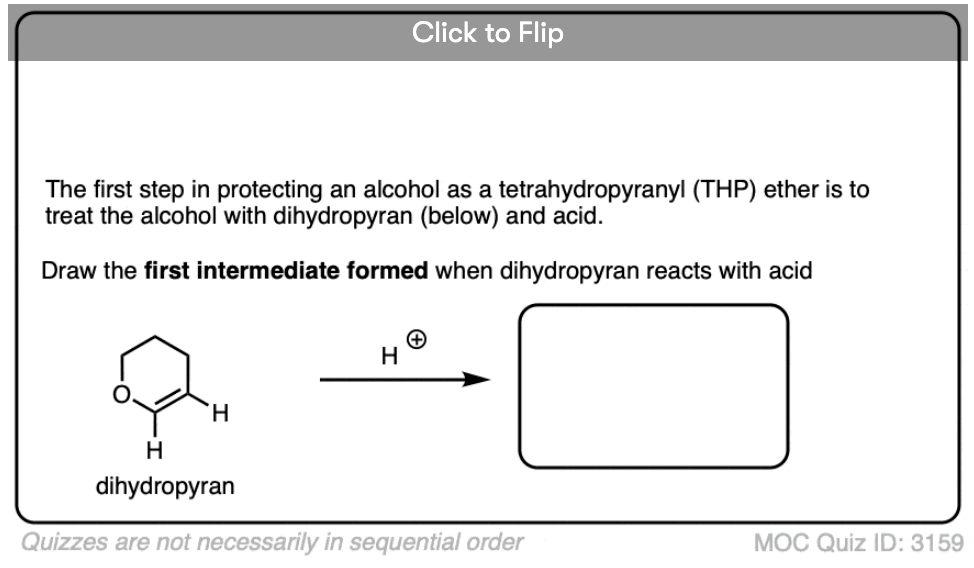
Become a MOC member to see the clickable quiz with answers on the back.
(Advanced) References and Further Reading
Protection as silyl ethers:
- Protection of hydroxyl groups as tert-butyldimethylsilyl derivatives
E. J. Corey and A. Venkateswarlu
Journal of the American Chemical Society 1972 94 (17), 6190-6191
DOI: 10.1021/ja00772a043
The original paper by Nobel Laureate Prof. E. J. Corey (Harvard) describing convenient conditions (TBS-Cl, DMF, imidazole) for the protection of alcohols as TBS-ethers. - GENERATION OF NONRACEMIC 2-(t-BUTYLDIMETHYLSILYLOXY)-3-BUTYNYLLITHIUM FROM (S)-ETHYL LACTATE: (S)-4-(t-BUTYLDIMETHYLSILYLOXY)-2-PENTYN-1-OL
James A. Marshall, Mathew M. Yanik, Nicholas D. Adams, Keith C. Ellis, and Harry R. Chobanian
Org. Synth. 2005, 81, 157
DOI: 10.15227/orgsyn.081.0157
The first step in this synthesis from Organic Syntheses (a source of reliable and reproducible synthetic organic experimental procedures) is O-silylation with TBSCl according to Corey’s procedure. - Protection of Hydroxy Groups by Silylation: Use in Peptide Synthesis and as Lipophilicity Modifiers for Peptides
John S. Davies, Clement L. Higginbotham, E. John Tremeer, Charles Brown, and Richard C. Treadgold
J. Chem. Soc., Perkin Trans. 1, 1992, 3043-3048
DOI:1039/p19920003043
This paper describes a kinetic study of the susceptibility to hydrolysis of various silyl ethers under acidic and basic conditions, and has a convenient table on the first page describing the results. - Symmetrical alkoxysilyl ethers. A new class of alcohol-protecting groups. Preparation of tert-butoxydiphenylsilyl ethers
John W. Gillard, Rejean Fortin, Howard E. Morton, Christiane Yoakim, Claude A. Quesnelle, Sylvain Daignault, and Yvan Guindon
The Journal of Organic Chemistry 1988 53 (11), 2602-2608
DOI: 1021/jo00246a038
This paper describes the use of -SiPh2OtBu as a protecting group for alcohols which is easier to remove with F– compared to conventional -TBDPS ethers. - Selective Deprotection of Silyl Ethers
Todd D. Nelson, R. David Crouch
Synthesis 1996; 1996(9): 1031-1069
DOI:1055/s-1996-4350
This review covers the selective removal of silyl ethers in the presence of similar or different silyl ether groups in the same molecule. In organic synthesis, deprotection strategies are just as important as protection strategies!Ethers can also be used for alcohol protection. Two common ether-based protecting groups are THP- (tetrahydropyranyl-) and MOM- (methoxymethyl-). - Pyridinium p-toluenesulfonate. A mild and efficient catalyst for the tetrahydropyranylation of alcohols
Masaaki Miyashita, Akira Yoshikoshi, and Paul A. Grieco
The Journal of Organic Chemistry 1977, 42 (23), 3772-3774
DOI: 1021/jo00443a038
While p-toluenesulfonic acid is generally used as the catalyst for tetrahydropyranylation of alcohols, PPTS (the pyridine salt of p-toluenesulfonic acid) can be used as an even milder catalyst for this reaction. This is of value when trying to protect an alcohol with several other delicate functional groups in the molecule. - Total synthesis of (S)-12-hydroxy-5,8,14-cis,-10-trans-eicosatetraenoic acid (Samuelsson’s HETE)
E. J. Corey, Haruki Niwa, and Jochen Knolle
Journal of the American Chemical Society 1978, 100 (6), 1942-1943
DOI: 10.1021/ja00474a058
This paper demonstrates a synthetic strategy using alcohol protecting groups. One of the -OH in a substrate groups is protected as a THP ether (conditions not mentioned), and later deprotected, using p-TSA in methanol, 1h at RT, 94% yield. - Diastereo‐ and Enantioselective Total Synthesis of Stigmatellin A
Dieter Enders Prof. Dr. Gunter Geibel Dr. Simon Osborne Dr.
Eur. J. 2000, 16 (8), 1302-1309
DOI: 10.1002/(SICI)1521-3765(20000417)6:8<1302::AID-CHEM1302>3.0.CO;2-J
9 -> 3 involves a MOM protection. Interestingly, this is selective for one of the hydroxyl groups in the molecule, since, as the paper says, “the second hydroxyl group is blocked by a hydrogen bond to the carbonyl function in [the] ortho-position”. This shows that the way we commonly draw structures does not always reflect the preferred conformation!
Protecting with the MOM- group is commonly done using MOM-Cl (methoxymethyl chloride). However, due to this compound’s extreme toxicity (it is a powerful alkylating agent and can alkylate proteins and nucleic acids in our bodies), alternative methods for protection are sought, and the following two papers by Nobel Laureate Prof. G. A. Olah give alternative methods for MOM- protection of alcohols without using MOM-Cl. - Iodotrimethylsilane-Catalyzed Preparation of Methoxymethyl Ethers of Primary and Secondary Alcohols with Dimethoxymethane
George A. Olah, Altaf Husain, Subhash C. Narang
Synthesis 1983, 11, 896-897
DOI: 10.1055/s-1983-30554 - Synthesis of terrein, a metabolite of Aspergillus terreus
Joseph Auerbach and Steven M. Weinreb
Chem. Soc. Chem. Comm. 1974, 298-299
DOI: 10.1039/C39740000298
This paper demonstrates the use of MOM- protection in total synthesis. Two -OH groups are initially protected as MOM ethers by deprotecting to the alkoxides with NaH, followed by MOM-Cl in DMF at RT. At the end of the synthesis, the protecting groups were removed using “a trace of concentrated HCl in MeOH at 62° for 15 min”.
00 General Chemistry Review
01 Bonding, Structure, and Resonance
- How Do We Know Methane (CH4) Is Tetrahedral?
- Hybrid Orbitals and Hybridization
- How To Determine Hybridization: A Shortcut
- Orbital Hybridization And Bond Strengths
- Sigma bonds come in six varieties: Pi bonds come in one
- A Key Skill: How to Calculate Formal Charge
- The Four Intermolecular Forces and How They Affect Boiling Points
- 3 Trends That Affect Boiling Points
- How To Use Electronegativity To Determine Electron Density (and why NOT to trust formal charge)
- Introduction to Resonance
- How To Use Curved Arrows To Interchange Resonance Forms
- Evaluating Resonance Forms (1) - The Rule of Least Charges
- How To Find The Best Resonance Structure By Applying Electronegativity
- Evaluating Resonance Structures With Negative Charges
- Evaluating Resonance Structures With Positive Charge
- Exploring Resonance: Pi-Donation
- Exploring Resonance: Pi-acceptors
- In Summary: Evaluating Resonance Structures
- Drawing Resonance Structures: 3 Common Mistakes To Avoid
- How to apply electronegativity and resonance to understand reactivity
- Bond Hybridization Practice
- Structure and Bonding Practice Quizzes
- Resonance Structures Practice
02 Acid Base Reactions
- Introduction to Acid-Base Reactions
- Acid Base Reactions In Organic Chemistry
- The Stronger The Acid, The Weaker The Conjugate Base
- Walkthrough of Acid-Base Reactions (3) - Acidity Trends
- Five Key Factors That Influence Acidity
- Acid-Base Reactions: Introducing Ka and pKa
- How to Use a pKa Table
- The pKa Table Is Your Friend
- A Handy Rule of Thumb for Acid-Base Reactions
- Acid Base Reactions Are Fast
- pKa Values Span 60 Orders Of Magnitude
- How Protonation and Deprotonation Affect Reactivity
- Acid Base Practice Problems
03 Alkanes and Nomenclature
- Meet the (Most Important) Functional Groups
- Condensed Formulas: Deciphering What the Brackets Mean
- Hidden Hydrogens, Hidden Lone Pairs, Hidden Counterions
- Don't Be Futyl, Learn The Butyls
- Primary, Secondary, Tertiary, Quaternary In Organic Chemistry
- Branching, and Its Affect On Melting and Boiling Points
- The Many, Many Ways of Drawing Butane
- Wedge And Dash Convention For Tetrahedral Carbon
- Common Mistakes in Organic Chemistry: Pentavalent Carbon
- Table of Functional Group Priorities for Nomenclature
- Summary Sheet - Alkane Nomenclature
- Organic Chemistry IUPAC Nomenclature Demystified With A Simple Puzzle Piece Approach
- Boiling Point Quizzes
- Organic Chemistry Nomenclature Quizzes
04 Conformations and Cycloalkanes
- Staggered vs Eclipsed Conformations of Ethane
- Conformational Isomers of Propane
- Newman Projection of Butane (and Gauche Conformation)
- Introduction to Cycloalkanes
- Geometric Isomers In Small Rings: Cis And Trans Cycloalkanes
- Calculation of Ring Strain In Cycloalkanes
- Cycloalkanes - Ring Strain In Cyclopropane And Cyclobutane
- Cyclohexane Conformations
- Cyclohexane Chair Conformation: An Aerial Tour
- How To Draw The Cyclohexane Chair Conformation
- The Cyclohexane Chair Flip
- The Cyclohexane Chair Flip - Energy Diagram
- Substituted Cyclohexanes - Axial vs Equatorial
- Ranking The Bulkiness Of Substituents On Cyclohexanes: "A-Values"
- Cyclohexane Chair Conformation Stability: Which One Is Lower Energy?
- Fused Rings - Cis-Decalin and Trans-Decalin
- Naming Bicyclic Compounds - Fused, Bridged, and Spiro
- Bredt's Rule (And Summary of Cycloalkanes)
- Newman Projection Practice
- Cycloalkanes Practice Problems
05 A Primer On Organic Reactions
- The Most Important Question To Ask When Learning a New Reaction
- Curved Arrows (for reactions)
- Nucleophiles and Electrophiles
- The Three Classes of Nucleophiles
- Nucleophilicity vs. Basicity
- What Makes A Good Nucleophile?
- What Makes A Good Leaving Group?
- 3 Factors That Stabilize Carbocations
- Equilibrium and Energy Relationships
- 7 Factors that stabilize negative charge in organic chemistry
- 7 Factors That Stabilize Positive Charge in Organic Chemistry
- What's a Transition State?
- Hammond's Postulate
- Learning Organic Chemistry Reactions: A Checklist (PDF)
- Introduction to Oxidative Cleavage Reactions
06 Free Radical Reactions
- Free Radical Reactions
- 3 Factors That Stabilize Free Radicals
- Bond Strengths And Radical Stability
- Free Radical Initiation: Why Is "Light" Or "Heat" Required?
- Initiation, Propagation, Termination
- Monochlorination Products Of Propane, Pentane, And Other Alkanes
- Selectivity In Free Radical Reactions
- Selectivity in Free Radical Reactions: Bromination vs. Chlorination
- Halogenation At Tiffany's
- Allylic Bromination
- Bonus Topic: Allylic Rearrangements
- In Summary: Free Radicals
- Synthesis (2) - Reactions of Alkanes
- Free Radicals Practice Quizzes
07 Stereochemistry and Chirality
- Types of Isomers: Constitutional Isomers, Stereoisomers, Enantiomers, and Diastereomers
- How To Draw The Enantiomer Of A Chiral Molecule
- How To Draw A Bond Rotation
- Introduction to Assigning (R) and (S): The Cahn-Ingold-Prelog Rules
- Assigning Cahn-Ingold-Prelog (CIP) Priorities (2) - The Method of Dots
- Enantiomers vs Diastereomers vs The Same? Two Methods For Solving Problems
- Assigning R/S To Newman Projections (And Converting Newman To Line Diagrams)
- How To Determine R and S Configurations On A Fischer Projection
- The Meso Trap
- Optical Rotation, Optical Activity, and Specific Rotation
- Optical Purity and Enantiomeric Excess
- What's a Racemic Mixture?
- Chiral Allenes And Chiral Axes
- Stereochemistry Practice Problems and Quizzes
08 Substitution Reactions
- Nucleophilic Substitution Reactions - Introduction
- Two Types of Nucleophilic Substitution Reactions
- The SN2 Mechanism
- Why the SN2 Reaction Is Powerful
- The SN1 Mechanism
- The Conjugate Acid Is A Better Leaving Group
- Comparing the SN1 and SN2 Reactions
- Polar Protic? Polar Aprotic? Nonpolar? All About Solvents
- Steric Hindrance is Like a Fat Goalie
- Common Blind Spot: Intramolecular Reactions
- Substitution Practice - SN1
- Substitution Practice - SN2
09 Elimination Reactions
- Elimination Reactions (1): Introduction And The Key Pattern
- Elimination Reactions (2): The Zaitsev Rule
- Elimination Reactions Are Favored By Heat
- Two Elimination Reaction Patterns
- The E1 Reaction
- The E2 Mechanism
- E1 vs E2: Comparing the E1 and E2 Reactions
- Antiperiplanar Relationships: The E2 Reaction and Cyclohexane Rings
- Bulky Bases in Elimination Reactions
- Comparing the E1 vs SN1 Reactions
- Elimination (E1) Reactions With Rearrangements
- E1cB - Elimination (Unimolecular) Conjugate Base
- Elimination (E1) Practice Problems And Solutions
- Elimination (E2) Practice Problems and Solutions
10 Rearrangements
11 SN1/SN2/E1/E2 Decision
- Identifying Where Substitution and Elimination Reactions Happen
- Deciding SN1/SN2/E1/E2 (1) - The Substrate
- Deciding SN1/SN2/E1/E2 (2) - The Nucleophile/Base
- SN1 vs E1 and SN2 vs E2 : The Temperature
- Deciding SN1/SN2/E1/E2 - The Solvent
- Wrapup: The Key Factors For Determining SN1/SN2/E1/E2
- Alkyl Halide Reaction Map And Summary
- SN1 SN2 E1 E2 Practice Problems
12 Alkene Reactions
- E and Z Notation For Alkenes (+ Cis/Trans)
- Alkene Stability
- Alkene Addition Reactions: "Regioselectivity" and "Stereoselectivity" (Syn/Anti)
- Stereoselective and Stereospecific Reactions
- Hydrohalogenation of Alkenes and Markovnikov's Rule
- Hydration of Alkenes With Aqueous Acid
- Rearrangements in Alkene Addition Reactions
- Halogenation of Alkenes and Halohydrin Formation
- Oxymercuration Demercuration of Alkenes
- Hydroboration Oxidation of Alkenes
- m-CPBA (meta-chloroperoxybenzoic acid)
- OsO4 (Osmium Tetroxide) for Dihydroxylation of Alkenes
- Palladium on Carbon (Pd/C) for Catalytic Hydrogenation of Alkenes
- Cyclopropanation of Alkenes
- A Fourth Alkene Addition Pattern - Free Radical Addition
- Alkene Reactions: Ozonolysis
- Summary: Three Key Families Of Alkene Reaction Mechanisms
- Synthesis (4) - Alkene Reaction Map, Including Alkyl Halide Reactions
- Alkene Reactions Practice Problems
13 Alkyne Reactions
- Acetylides from Alkynes, And Substitution Reactions of Acetylides
- Partial Reduction of Alkynes With Lindlar's Catalyst
- Partial Reduction of Alkynes With Na/NH3 To Obtain Trans Alkenes
- Alkyne Hydroboration With "R2BH"
- Hydration and Oxymercuration of Alkynes
- Hydrohalogenation of Alkynes
- Alkyne Halogenation: Bromination and Chlorination of Alkynes
- Oxidation of Alkynes With O3 and KMnO4
- Alkenes To Alkynes Via Halogenation And Elimination Reactions
- Alkynes Are A Blank Canvas
- Synthesis (5) - Reactions of Alkynes
- Alkyne Reactions Practice Problems With Answers
14 Alcohols, Epoxides and Ethers
- Alcohols - Nomenclature and Properties
- Alcohols Can Act As Acids Or Bases (And Why It Matters)
- Alcohols - Acidity and Basicity
- The Williamson Ether Synthesis
- Ethers From Alkenes, Tertiary Alkyl Halides and Alkoxymercuration
- Alcohols To Ethers via Acid Catalysis
- Cleavage Of Ethers With Acid
- Epoxides - The Outlier Of The Ether Family
- Opening of Epoxides With Acid
- Epoxide Ring Opening With Base
- Making Alkyl Halides From Alcohols
- Tosylates And Mesylates
- PBr3 and SOCl2
- Elimination Reactions of Alcohols
- Elimination of Alcohols To Alkenes With POCl3
- Alcohol Oxidation: "Strong" and "Weak" Oxidants
- Demystifying The Mechanisms of Alcohol Oxidations
- Protecting Groups For Alcohols
- Thiols And Thioethers
- Calculating the oxidation state of a carbon
- Oxidation and Reduction in Organic Chemistry
- Oxidation Ladders
- SOCl2 Mechanism For Alcohols To Alkyl Halides: SN2 versus SNi
- Alcohol Reactions Roadmap (PDF)
- Alcohol Reaction Practice Problems
- Epoxide Reaction Quizzes
- Oxidation and Reduction Practice Quizzes
15 Organometallics
- What's An Organometallic?
- Formation of Grignard and Organolithium Reagents
- Organometallics Are Strong Bases
- Reactions of Grignard Reagents
- Protecting Groups In Grignard Reactions
- Synthesis Problems Involving Grignard Reagents
- Grignard Reactions And Synthesis (2)
- Organocuprates (Gilman Reagents): How They're Made
- Gilman Reagents (Organocuprates): What They're Used For
- The Heck, Suzuki, and Olefin Metathesis Reactions (And Why They Don't Belong In Most Introductory Organic Chemistry Courses)
- Reaction Map: Reactions of Organometallics
- Grignard Practice Problems
16 Spectroscopy
- Degrees of Unsaturation (or IHD, Index of Hydrogen Deficiency)
- Conjugation And Color (+ How Bleach Works)
- Introduction To UV-Vis Spectroscopy
- UV-Vis Spectroscopy: Absorbance of Carbonyls
- UV-Vis Spectroscopy: Practice Questions
- Bond Vibrations, Infrared Spectroscopy, and the "Ball and Spring" Model
- Infrared Spectroscopy: A Quick Primer On Interpreting Spectra
- IR Spectroscopy: 4 Practice Problems
- 1H NMR: How Many Signals?
- Homotopic, Enantiotopic, Diastereotopic
- Diastereotopic Protons in 1H NMR Spectroscopy: Examples
- 13-C NMR - How Many Signals
- Liquid Gold: Pheromones In Doe Urine
- Natural Product Isolation (1) - Extraction
- Natural Product Isolation (2) - Purification Techniques, An Overview
- Structure Determination Case Study: Deer Tarsal Gland Pheromone
17 Dienes and MO Theory
- What To Expect In Organic Chemistry 2
- Are these molecules conjugated?
- Conjugation And Resonance In Organic Chemistry
- Bonding And Antibonding Pi Orbitals
- Molecular Orbitals of The Allyl Cation, Allyl Radical, and Allyl Anion
- Pi Molecular Orbitals of Butadiene
- Reactions of Dienes: 1,2 and 1,4 Addition
- Thermodynamic and Kinetic Products
- More On 1,2 and 1,4 Additions To Dienes
- s-cis and s-trans
- The Diels-Alder Reaction
- Cyclic Dienes and Dienophiles in the Diels-Alder Reaction
- Stereochemistry of the Diels-Alder Reaction
- Exo vs Endo Products In The Diels Alder: How To Tell Them Apart
- HOMO and LUMO In the Diels Alder Reaction
- Why Are Endo vs Exo Products Favored in the Diels-Alder Reaction?
- Diels-Alder Reaction: Kinetic and Thermodynamic Control
- The Retro Diels-Alder Reaction
- The Intramolecular Diels Alder Reaction
- Regiochemistry In The Diels-Alder Reaction
- The Cope and Claisen Rearrangements
- Electrocyclic Reactions
- Electrocyclic Ring Opening And Closure (2) - Six (or Eight) Pi Electrons
- Diels Alder Practice Problems
- Molecular Orbital Theory Practice
18 Aromaticity
- Introduction To Aromaticity
- Rules For Aromaticity
- Huckel's Rule: What Does 4n+2 Mean?
- Aromatic, Non-Aromatic, or Antiaromatic? Some Practice Problems
- Antiaromatic Compounds and Antiaromaticity
- The Pi Molecular Orbitals of Benzene
- The Pi Molecular Orbitals of Cyclobutadiene
- Frost Circles
- Aromaticity Practice Quizzes
19 Reactions of Aromatic Molecules
- Electrophilic Aromatic Substitution: Introduction
- Activating and Deactivating Groups In Electrophilic Aromatic Substitution
- Electrophilic Aromatic Substitution - The Mechanism
- Ortho-, Para- and Meta- Directors in Electrophilic Aromatic Substitution
- Understanding Ortho, Para, and Meta Directors
- Why are halogens ortho- para- directors?
- Disubstituted Benzenes: The Strongest Electron-Donor "Wins"
- Electrophilic Aromatic Substitutions (1) - Halogenation of Benzene
- Electrophilic Aromatic Substitutions (2) - Nitration and Sulfonation
- EAS Reactions (3) - Friedel-Crafts Acylation and Friedel-Crafts Alkylation
- Intramolecular Friedel-Crafts Reactions
- Nucleophilic Aromatic Substitution (NAS)
- Nucleophilic Aromatic Substitution (2) - The Benzyne Mechanism
- Reactions on the "Benzylic" Carbon: Bromination And Oxidation
- The Wolff-Kishner, Clemmensen, And Other Carbonyl Reductions
- More Reactions on the Aromatic Sidechain: Reduction of Nitro Groups and the Baeyer Villiger
- Aromatic Synthesis (1) - "Order Of Operations"
- Synthesis of Benzene Derivatives (2) - Polarity Reversal
- Aromatic Synthesis (3) - Sulfonyl Blocking Groups
- Birch Reduction
- Synthesis (7): Reaction Map of Benzene and Related Aromatic Compounds
- Aromatic Reactions and Synthesis Practice
- Electrophilic Aromatic Substitution Practice Problems
20 Aldehydes and Ketones
- What's The Alpha Carbon In Carbonyl Compounds?
- Nucleophilic Addition To Carbonyls
- Aldehydes and Ketones: 14 Reactions With The Same Mechanism
- Sodium Borohydride (NaBH4) Reduction of Aldehydes and Ketones
- Grignard Reagents For Addition To Aldehydes and Ketones
- Wittig Reaction
- Hydrates, Hemiacetals, and Acetals
- Imines - Properties, Formation, Reactions, and Mechanisms
- All About Enamines
- Breaking Down Carbonyl Reaction Mechanisms: Reactions of Anionic Nucleophiles (Part 2)
- Aldehydes Ketones Reaction Practice
21 Carboxylic Acid Derivatives
- Nucleophilic Acyl Substitution (With Negatively Charged Nucleophiles)
- Addition-Elimination Mechanisms With Neutral Nucleophiles (Including Acid Catalysis)
- Basic Hydrolysis of Esters - Saponification
- Transesterification
- Proton Transfer
- Fischer Esterification - Carboxylic Acid to Ester Under Acidic Conditions
- Lithium Aluminum Hydride (LiAlH4) For Reduction of Carboxylic Acid Derivatives
- LiAlH[Ot-Bu]3 For The Reduction of Acid Halides To Aldehydes
- Di-isobutyl Aluminum Hydride (DIBAL) For The Partial Reduction of Esters and Nitriles
- Amide Hydrolysis
- Thionyl Chloride (SOCl2) And Conversion of Carboxylic Acids to Acid Halides
- Diazomethane (CH2N2)
- Carbonyl Chemistry: Learn Six Mechanisms For the Price Of One
- Making Music With Mechanisms (PADPED)
- Carboxylic Acid Derivatives Practice Questions
22 Enols and Enolates
- Keto-Enol Tautomerism
- Enolates - Formation, Stability, and Simple Reactions
- Kinetic Versus Thermodynamic Enolates
- Aldol Addition and Condensation Reactions
- Reactions of Enols - Acid-Catalyzed Aldol, Halogenation, and Mannich Reactions
- Claisen Condensation and Dieckmann Condensation
- Decarboxylation
- The Malonic Ester and Acetoacetic Ester Synthesis
- The Michael Addition Reaction and Conjugate Addition
- The Robinson Annulation
- Haloform Reaction
- The Hell–Volhard–Zelinsky Reaction
- Enols and Enolates Practice Quizzes
23 Amines
- The Amide Functional Group: Properties, Synthesis, and Nomenclature
- Basicity of Amines And pKaH
- 5 Key Basicity Trends of Amines
- The Mesomeric Effect And Aromatic Amines
- Nucleophilicity of Amines
- Alkylation of Amines (Sucks!)
- Reductive Amination
- The Gabriel Synthesis
- Some Reactions of Azides
- The Hofmann Elimination
- The Hofmann and Curtius Rearrangements
- The Cope Elimination
- Protecting Groups for Amines - Carbamates
- The Strecker Synthesis of Amino Acids
- Introduction to Peptide Synthesis
- Reactions of Diazonium Salts: Sandmeyer and Related Reactions
- Amine Practice Questions
24 Carbohydrates
- D and L Notation For Sugars
- Pyranoses and Furanoses: Ring-Chain Tautomerism In Sugars
- What is Mutarotation?
- Reducing Sugars
- The Big Damn Post Of Carbohydrate-Related Chemistry Definitions
- The Haworth Projection
- Converting a Fischer Projection To A Haworth (And Vice Versa)
- Reactions of Sugars: Glycosylation and Protection
- The Ruff Degradation and Kiliani-Fischer Synthesis
- Isoelectric Points of Amino Acids (and How To Calculate Them)
- Carbohydrates Practice
- Amino Acid Quizzes
25 Fun and Miscellaneous
- A Gallery of Some Interesting Molecules From Nature
- Screw Organic Chemistry, I'm Just Going To Write About Cats
- On Cats, Part 1: Conformations and Configurations
- On Cats, Part 2: Cat Line Diagrams
- On Cats, Part 4: Enantiocats
- On Cats, Part 6: Stereocenters
- Organic Chemistry Is Shit
- The Organic Chemistry Behind "The Pill"
- Maybe they should call them, "Formal Wins" ?
- Why Do Organic Chemists Use Kilocalories?
- The Principle of Least Effort
- Organic Chemistry GIFS - Resonance Forms
- Reproducibility In Organic Chemistry
- What Holds The Nucleus Together?
- How Reactions Are Like Music
- Organic Chemistry and the New MCAT
26 Organic Chemistry Tips and Tricks
- Common Mistakes: Formal Charges Can Mislead
- Partial Charges Give Clues About Electron Flow
- Draw The Ugly Version First
- Organic Chemistry Study Tips: Learn the Trends
- The 8 Types of Arrows In Organic Chemistry, Explained
- Top 10 Skills To Master Before An Organic Chemistry 2 Final
- Common Mistakes with Carbonyls: Carboxylic Acids... Are Acids!
- Planning Organic Synthesis With "Reaction Maps"
- Alkene Addition Pattern #1: The "Carbocation Pathway"
- Alkene Addition Pattern #2: The "Three-Membered Ring" Pathway
- Alkene Addition Pattern #3: The "Concerted" Pathway
- Number Your Carbons!
- The 4 Major Classes of Reactions in Org 1
- How (and why) electrons flow
- Grossman's Rule
- Three Exam Tips
- A 3-Step Method For Thinking Through Synthesis Problems
- Putting It Together
- Putting Diels-Alder Products in Perspective
- The Ups and Downs of Cyclohexanes
- The Most Annoying Exceptions in Org 1 (Part 1)
- The Most Annoying Exceptions in Org 1 (Part 2)
- The Marriage May Be Bad, But the Divorce Still Costs Money
- 9 Nomenclature Conventions To Know
- Nucleophile attacks Electrophile
27 Case Studies of Successful O-Chem Students
- Success Stories: How Corina Got The The "Hard" Professor - And Got An A+ Anyway
- How Helena Aced Organic Chemistry
- From a "Drop" To B+ in Org 2 – How A Hard Working Student Turned It Around
- How Serge Aced Organic Chemistry
- Success Stories: How Zach Aced Organic Chemistry 1
- Success Stories: How Kari Went From C– to B+
- How Esther Bounced Back From a "C" To Get A's In Organic Chemistry 1 And 2
- How Tyrell Got The Highest Grade In Her Organic Chemistry Course
- This Is Why Students Use Flashcards
- Success Stories: How Stu Aced Organic Chemistry
- How John Pulled Up His Organic Chemistry Exam Grades
- Success Stories: How Nathan Aced Organic Chemistry (Without It Taking Over His Life)
- How Chris Aced Org 1 and Org 2
- Interview: How Jay Got an A+ In Organic Chemistry
- How to Do Well in Organic Chemistry: One Student's Advice
- "America's Top TA" Shares His Secrets For Teaching O-Chem
- "Organic Chemistry Is Like..." - A Few Metaphors
- How To Do Well In Organic Chemistry: Advice From A Tutor
- Guest post: "I went from being afraid of tests to actually looking forward to them".
is it possible in a diol to protect only one oh with THP?
Generally no. You can often selectively protect a primary alcohol with a trityl group (triphenylmethyl). There are other situations where you can selectively protect one of the alcohols but unless you are in graduate school it’s not worth getting into them.
I will try that. Although, the aldehyde is solid and not liquid.
Dissolve it up in THF or whatever solvent you’re using to make the enolate as a dilute solution (e.g. 0.2 M)
A million thanks. You are such a rare gem.
I have tried several times using NaOH, KOH, MgI2, as well as acid catalysis using HCl, but all to no avail (the aldehyde was not deprotonating to form chalcone). I am thinking of using NaH this time around and that’s why am concerned about protecting the hydroxy group.
Why not just pre-form the enolate with LDA in THF and then add your aldehyde dropwise at low temp? The OH could end up protonating your enolate, but it’s pretty sterically hindered.
I’m using 3,5-di-tert-butyl-4-hydroxybenzaldehyde. I want to condense it with Acetophenone to form (E)-3-(3,5-di-tert-butyl-4-hydroxyphenyl)-1-phenylprop-2-en-1-one
I’m using 3,5-di-tert-butyl-4-hydroxybenzaldehyde. I want to condense it with Acetophenone to form (E)-3-(3,5-di-tert-butyl-4-hydroxyphenyl)-1-phenylprop-2-en-1-one.
In that case, it would be hard to protect since it’s sandwiched between those t-butyl groups.
Have you tried running the reaction anyways? Do you pre-form the enolate of acetophenone and then add the aldehyde? Curious if the OH would give you problems.
Otherwise this is basically a Claisen-Schmidt reaction, of which about a billion examples exist, under conditions where the enolate forms reversibly and a slight excess of base, I would imagine you could get this to go.
I want to do an aldol condensation with hydroxybenzaldehyde using a strong base. How can I protect OH group in the presence of aldehyde ?
Which hydroxybenzaldehyde are you starting with?
The usual procedure would be to start with a methoxybenzaldehyde and then try to remove the CH3 after your aldol with something like TMSI.
One milder way to do it would be to treat the hydroxybenzadehyde with KH and BnBr to make the O-benzylated benzaldehyde and then after your aldol, treat with Pd-C, H2. Or paramethoxybenzyl (PMB) and deprotect with DDQ.
How would I deprotect OMe in presence of CH2OH?
Deprotecting OMe is never fun. It depends on how stable the rest of your molecule is. I would employ basic conditions (RS- , polar aprotic solvent) since acidic conditions will likely ionize the CH2OH. Without knowing what the rest of the molecule looks like, it’s hard to say.
I want to protect aliphatic OH in the presence of aromatic OH, give me the suggestion.
Without knowing what your molecule looks like it’s hard to say. It would be easy to selectively protect the aromatic OH because it’s considerably more acidic, and once you form the alkoxide it will be far more nucleophilic. One idea would be to just protect both groups, and then selectively deprotect the aromatic OH afterwards.
please tell the alcohol protection with uv active group
Usually 2-nitrobenzyl. See https://en.wikipedia.org/wiki/Photolabile_protecting_group
How would I protect an NH2 group during and EAS reaction and why would I need to do so?
Suppose you have a primary and a secondary alcohol in a molecule. Would TMS prefer one over the other? Why?
In theory primary alcohols are less sterically hindered than secondary alcohols. You would think that TMS might be selective for primary. It is, but to a very minor extent. In order to get very good selectivity for primary over secondary, you have to use a very bulky protecting group like TBDPSCl or TIPSCl or trityl chloride. But like I said you have to make the protecting group much bigger than TMS.
Hello,
I had a few questions, as i’m learning organic synthesis,
i understood that the silylmethylether can be attacted by R- if there is not a good leaving group such as (Br, Cl, OTs), is that correct because i didn’t read something about that here?
Thank you very much!
I’m not sure what “attracted by R- means”. Could you elaborate?
TBDMS-Cl is superior to TMS-Cl for selective protection of an alcohol group, why
Much bulkier and therefore more sensitive to steric factors. However I’d go even further and use TBDPS.
which protecting group can be used to protect OH group in presence of carboxyl functional group(not to be protected)?
Silyl groups are fine, benzyl groups are fine. Lots of options.
I am trying to protect aryl OH with trimethyl silyl chloride using HMDS base. In the reaction it is showing different spot on TLC. But when we do column chromatography. It only gives starting back. Does silyl protection breaks during column chromatography?
What is the solution? Please help me.
TMS groups are extremely labile, especially on a phenol hydroxyl group. If you’re going to go with a silyl group, then pick TBS or something heavier.
How does the addition/ removal of a protecting group affect stereochemistry? For example a hydroxyl OH group on a wedge or dash would it remain the same or be changed?
Won’t be affected. It’s like deprotonation, you’re only affecting the O-PG bond. To invert the stereochem you’d have to invert the C-O bond.
Why can’t tertiary alcohols be protected by tetrahydropyranyl
ether?
I wouldn’t say this a 100% restriction – there are likely exceptions – but if you’re being taught this, here’s at least two reasons.
1. THP protection involves using strong acid, and strong acid might protonate the OH, resulting in loss of water to form a (stable) tertiary carbocation.
2. Tertiary alcohols are quite sterically hindered, and the rate of attack of the tertiary alcohol at the electrophile produced by protonation of DHP might be slow.
Hope this helps! James
Thanks for the suggestion I will look into it in more details.
I am looking for ways to protect a hydroxyl group on the bone of a molecule that has a carboxyl group at the end that needs to remain active. Is it possible to mask an OH on the bone while to acid at the end of chain remains ” active ” ?
Richard
try to chlorinate the carboxyl group, then protect the hydroxyl group, and then add water to the molecule, producing your desired product. use a protecting agent that doesn’t react with aqueous hcl, which will be produced from the reaction of water with the cocl group on the end of your molecule.
Thanks for the amazingly detailed post! Love the example with the painter’s tape.